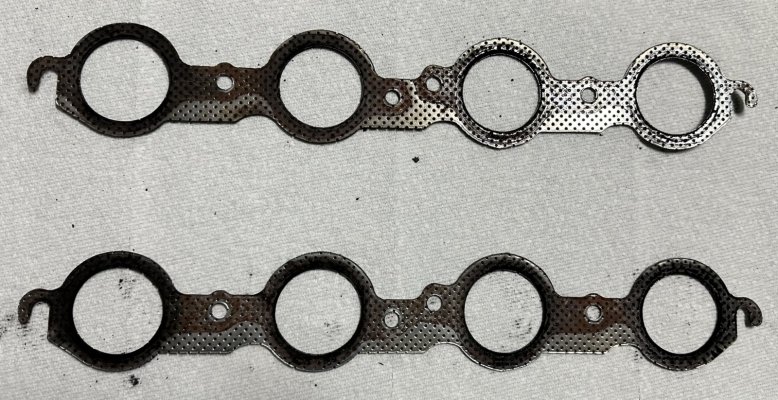CruelJung
Member
- Joined
- Jul 11, 2022
- Posts
- 43
- Reaction score
- 55
Firstly, I want to thank all of you for replying to this. This community is amazing and I am grateful for the opportunity to be part of it.I have been driving my '08 Yukon XL for nearly four years now, and it has always made a 'ticking' noise on cold startup. This noise subsides within a minute or so, as the engine temperature rises. No CEL or codes. Over the past four years I have been gaining more automotive knowledge and competency, as well as developing a general obsession with this vehicle--how it runs, how it sounds, how my maintenance/repair choices will affect a trajectory towards supercharging one day...
So, I started chasing this 'ticking' noise a few months ago because I noticed an exaggerated form of it under load while driving with the window down. When looking for a busted exhaust manifold bolt, I found that the second-to-rearmost manifold bolt on the passenger side was loose enough to turn with my fingers. There was also soot visible in a few areas above and below the manifold flange. I torqued all 12 bolts to 18 ft. lbs.--noting that all but one bolt were under 11 ft. lbs.--and the result was less noise for less time when cold starting and still noise under load.
Having some free time, last week, I decided to revisit the manifold bolts again because the cold start 'tick' duration seemed to be increasing. Sure enough, the bolts were under the 18 ft. lb. torque spec again and--once re-torqued--the cold start noise level and duration were reduced.
Presuming that the sound (when cold and under load, but dissipating in idle from cold to operating temperature), visible soot, loose bolts (potentially walked out and damaged gasket seal?) point towards an exhaust leak, I am planning to do the following:
1. Replace the current, rusty hardware with ARP header bolts
a. Leaning towards ARP 434-1102 (SS, hex)
b. Considering ARP 434-1301 (SS, stud/nut)
2. In conjunction, replace the exhaust manifold gasket (without removing manifold entirely--i.e., not disconnecting from Y-pipe)
a. Leaning towards OEM (Genuine GM), AC Delco, or Mahle
b. Considering a Remflex gasket or double Remflex gasket to compensate for any warping of the manifold
3. See what happens
a. If the sound persists, I will try to tighten the studs (manifold to Y-pipe).
b. If sound STILL persists after "a.", then I will remove manifold entirely to inspect, replace manifold-to-Y-pipe gaskets, and potentially replace the manifold.
With all of that said, do any of you with experience have some advice for the materials, process, or--for that matter--diagnosis?
At this point, I have the manifold gaskets and bolts (see attached image). After double-checking what I thought I knew, it seemed the general consensus was NOT to use stainless steel bolts--with the potential exception of using ARP's recommended install lubricant/anti-seize. Aesthetics can play a role in my decisions sometimes, but my initial pull towards SS was for what I theorized to be better utility. How wrong I was. Anyway, I went with ARP's 134-1102, which is a 3/8" flange chromoly hex-head M8 bolt. Also, I could not find what looked like a reputable option for a genuine GM gasket online and I saw a few positive posts about Mahle (which apparently owns Victor Reinz--did not previously know this), so I went that route.
So, what I would like to do is change my exhaust manifold bolts and gasket without detaching the manifold from the down-pipes/cats and I have some ideas (questions after):
1. Take out exhaust manifold bolts and let exhaust (with manifold attached) drop to allow maximum space to prep surfaces for new gaskets. Complete the rest of the work...
2. Remove the inner four exhaust manifold bolts, leaving the outer two just threaded enough to hold up the manifold, cut out and remove the old gasket, try to prep surfaces as best as possible, *cut out the bottom of the outer two bolt holes in the new gasket (creating hanger hook ends for the gasket to be draped over the still remaining original bolts)*, place the new gaskets, install the new ARP bolts in the inner four areas, then remove the outer two original bolts and replace them with the new ARPs.
3. Begin the same way as in option "2," to the point of having the surfaces prepped and only the two outer (original) bolts remaining in place to hold up the manifold. Instead of altering the new gaskets, I will install an ARP bolt in the second to rearmost hole (for support), remove the rearmost (original) bolt and replace it with another ARP *with* the corresponding gasket section, remove the support ARP bolt (second to rearmost) and install the new ARP bolt and gasket on the opposite end, then install the middle four ARP bolts.
Presuming any of these options are even possible (also, presuming this is a two-man job):
-What should I clean the mating surface with (tools, solvents) and how can I best keep my exhaust ports clean of debris while doing so (especially if I don't let my exhaust 'drop' out of the way and my working space is limited)?
-I am thinking my exhaust can 'drop' out of the way because of the flex pipe and cross member below the oil pan to support it. How wrong am I about that?
-If I lower the exhaust as mentioned above, should I do both sides together or separately?
-Is it a bad idea to trim the new gasket under the outer bolt holes and should I expect any potential gasket failure if doing so?
-Are the other gaskets in the pictured kit for an EGR on other applicable vehicles?
-Are there any other concerns that I am not even foreseeing?
Thank you, again!
Attachments
Last edited:






